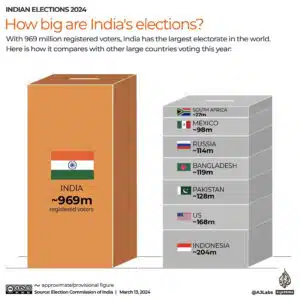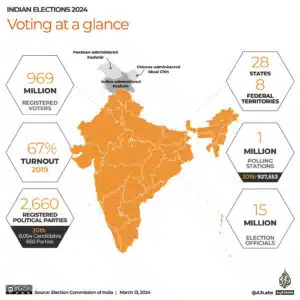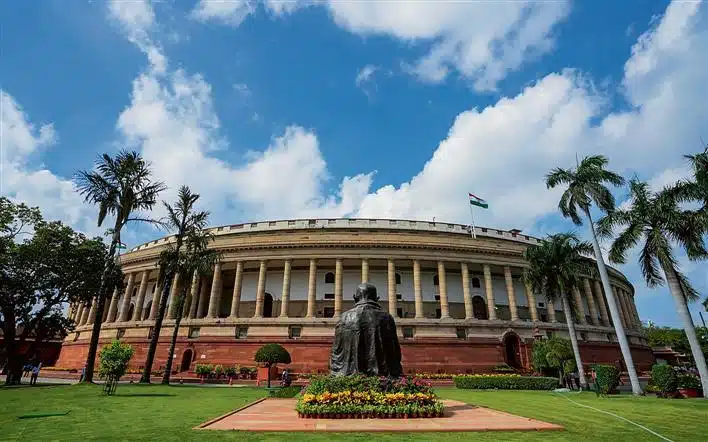India will hold general elections from April 19 through June 1, 2024, in what will be the largest, most expensive democratic exercise in history. Nearly 970 million eligible voters will cast their ballots through 5.5 million electronic voting machines across 1.05 million polling stations to elect representatives to the national parliament, and voters in four states will also select their state assembly representatives at the same time. Votes will be counted by June 4, and a new government is expected to be in place by early July. The entire exercise will cost an estimated 1.2 trillion rupees ($14.4 billion), double the amount spent on the previous elections in 2019.

India’s parliamentary system consists of the Lok Sabha (House of the People), which is the lower house of Parliament, and the Rajya Sabha (Council of States), which is the upper house of Parliament. The Lok Sabha consists of 543 elected seats, elected directly by the people through general elections held every five years, and any party or coalition needs a simple majority of 272 seats to form a government. By contrast, the Rajya Sabha consists of 250 members, of which 238 are elected by the legislatures of the state and union territories, while the president can appoint 12 members.
The Election Commission of India (ECI) oversees the election process to ensure it is free, fair, and impartial. The logistical challenges of this election are immense, with about 15 million polling staff and security personnel deployed across diverse and sometimes remote terrains, from the Himalayas to desert regions and sparsely populated islands. Turnout this year is expected to equal or exceed the record set in 2019, when voter turnout reached 67.4 percent and women’s participation also reached a historic high of 67.18 percent. The ECI’s preparations involve a comprehensive assessment of election readiness across various states, addressing potential issues to ensure the smooth conduct of the voting process. The commission’s logistical operations include the deployment of electronic voting machines (EVMs), training of polling staff, and implementation of measures to enhance voter accessibility and participation, highlighting the immense scale and complexity of organizing general elections in the world’s largest democracy.

The current electoral contest includes approximately 2,660 registered political parties, showcasing India’s vibrant and diverse political landscape. The principal contenders are the ruling Bharatiya Janata Party (BJP), led by Prime Minister Narendra Modi, aiming for a third term with a target of 370 seats, and the main opposition, the Indian National Congress (INC) party, in partnership with several smaller regional opposition parties.
In terms of election strategy, the BJP has capitalized on its electoral funding advantage, which has allowed the party to maintain a campaign presence. It has also benefitted from forming alliances with regional parties, further strengthening its political base across India. The Congress (INC), on the other hand, is focusing on restructuring its strategy under the leadership of figures like Mallikarjun Kharge and Rahul Gandhi, who has been trying to position himself as a man of the people through initiatives like his 3,500km trek across the country. The Congress’s campaign in regions like Karnataka has demonstrated its resilience and relevance despite setbacks in previous general elections.
Key battles across various states highlight the diversity and complexity of the electoral landscape. For instance, in Chhattisgarh, the BJP aims to leverage its recent assembly poll victory to win all 11 Lok Sabha seats, posing a significant challenge for the Congress Party. In Odisha, Chief Minister Naveen Patnaik’s Hinjili seat is under the spotlight as he aims for a record sixth term. Andhra Pradesh is set to witness a fierce battle between Jagan Reddy’s YSR Congress Party and Chandrababu Naidu’s Telugu Desam Party. Bihar, with its unique political dynamics, will have six key Lok Sabha seats closely watched as it votes in seven phases. Additionally, for the first time in Indian election history, the Election Commission has introduced a ‘vote-from-home’ option for citizens aged 85 and above and for people with certain disabilities, marking a historic step towards inclusive voting.
Recent opinion polls suggest that the BJP and its allies could win around 335 of the 543 directly elected seats in the lower house of Parliament, indicating a clear majority but a slight reduction from their current tally. Nonetheless, the poll reflects enduring support for Modi, credited with accelerating growth, improving foreign ties, and promoting a nationalist agenda. The BJP’s recent state election victories have been associated with – in addition to PM Modi’s personal charisma – with a range of popular welfare schemes such as cash transfers, free rations, and affordable gas cylinders to aid over 800 million people, a strategy that might resonate with national voters amid current economic challenges.
In the event of a BJP victory, we expect the government will continue its key policy priorities of fiscal consolidation, investment promotion, and enhanced social welfare. Finance Minister Nirmala Sitharaman has projected a fiscal deficit of 5.1% of GDP in 2024 and plans to continue with the scheme of fifty-year interest-free loans for states for capital expenditure with an outlay of approximately $15.68 billion. The current budget retains the same tax rates for both direct and indirect taxes, with a focus on improving taxpayer services and offering tax benefits to start-ups and a significant increase in capital expenditure outlay for infrastructure development and employment generation. Additionally, the government has made allocations for the upliftment of various social segments, with schemes targeting the poor, women, youth, and farmers. These initiatives include financial assistance to farmers, credit assistance to street vendors, and loans for women entrepreneurs. In healthcare, there’s an extension of coverage under the Ayushman Bharat scheme to include all ASHA workers, Anganwadi Workers, and Helpers. The education sector is expected to see an expansion of medical colleges and the introduction of new programs for dairy farmers.
By Kudrat Soin, Communications and Research Intern at the US-India Strategic Partnership Forum.
By Malachy Nugent, Vice President, Financial Services at the US-India Strategic Partnership Forum.

